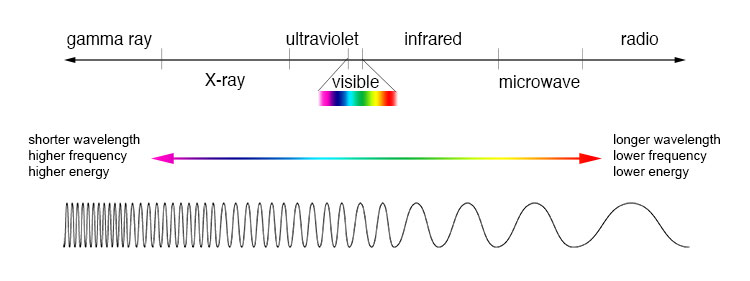First things first: What is light?
Light is the section of the electromagnetic spectrum that falls within the range of wavelengths the human eye is sensitive to. That range is approximately 400 nm to 700nm. The lower the wavelength the higher the frequency and thus the higher the energy - which gives the photons the power to do work to matter around it, including our bodies. Ionizing radiation at the lowest wavelength end are very destructive to living tissues. Even as high as ultraviolet (wavelengths just below the visible spectrum) can cause sunburn or damage to cell dna that results in cancer. But visible light only has the power to do work on very sensitive light receptors in your eyes.
How do we percieve color?
Human retinas contain 2 types of light receptors - “rods cells” (named that for their shape) are very sensitive to light overall but not more sensitive to one part of the visible spectrum than another. They work well in low light but they have little role in color vision. This is why things look grayer in low light. “Cone cells” (also named for their shape) come in three types for (most) 2 humans, which is called trichormatic vision. Each cell is sensitive to a slightly different range of wavelength. This means that when one type of cells is more excited than others, your brain interprets that as being more of “that color”. The three cells do not cover the spectrum evenly, leading even those with full color vision to be more sensitive to some contrasts than others. Other things can influence color vision, too. Including context.
Do you remember that stupid controversry of the blue/black white/gold dress from 2015? Half the internet saw it as one set of colors and the other half saw it as the other. And unlike the old lady/young lady optical illusion, it was not possible to force your perception into one or the other.
Light bounces off an object and hits your eyes - which parts of the spectrum make it to your retina is reliant on the physics of the object (e.g. leaves absorb nearly all the spectrum and only emit green) and the light hitting them (daylight/light bulbs/fire light, etc). Your brain tries to make colors consistent so it takes your perception of the ambient light and corrects the color you see by “subtracting” it. Some people saw the light of the background and “subtracted” it, resulting in percieving it as blue and some failed to and saw it as white. More details in that wired article, but the point is this:
Like many of our senses, color perception takes physical reality, mixes it with experience and integrates it into an idea. This fact is crucially important to understanding part 2, different ways to encode color.
-
(h/t NASA Goddard Space Flight Center) ↩
-
Color blindness is having a deficit of one or more types of cones. Most people have the L type, which peaks at 560 nm and still has some sensitivity for the full range, but may have less sensitivity to red/green distinctions. Some small number of people have been identified as having some of their long red cones mutated enough to be distinct sensitivity types, giving them tetrachromatic vision (4 color). If you’re curious about whether or not you’re color blind, you can take this online test but they’ll try to sell you corrective glasses for it! ↩
